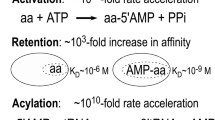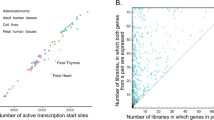Abstract
A correspondence between open reading frames in sense and antisense strands is expected from the hypothesis that the prototypic triplet code was of general form RNY, where R is a purine base, N is any base, and Y is a pyrimidine. A deficit of stop codons in the antisense strand (and thus long open reading frames) is predicted for organisms with high G + C percentages; however, two bacteria (Azotobacter vinelandii, Rhodobacter capsulatum) have larger average antisense strand open reading frames than predicted from (G + C)%. The similar Codon frequencies found in sense and antisense strands can be attributed to the wide distribution of inverted repeats (stem-loop potential) in natural DNA sequences.
Similar content being viewed by others
References
Alff-Steinberger C (1984) Evidence for a coding pattern on the noncoding strand of the E. coli genome. Nucleic Acids Res 12:2235–2241
Alff-Steinberger C (1987) Codon usage in Homo sapiens: evidence for a coding pattern on the non-coding strand and evolutionary implications of dinucleotide discrimination. J Theor Biol 124:89–95
Barrai I, Scapoli C, Gambari R, Brugnoli F (1991) Frequencies of codons in histones, tubulins and fibrinogen: bias due to interference between transcriptional signals and protein function. J Theor Biol 152:405–426
Biro J (1981a) The complementary coding of some proteins as the possible source of specificity in protein-protein interactions. Med Hypothesis 7:981–993
Biro J (1981b) Models of gene expression based on the sequential complementary coding of some pituitary proteins. Med Hypothesis 7:995–1007
Blalock JE (1990) Complementarity of peptides specified by “sense” and “antisense” strands of DNA. Trends Biotechnol 8:140–144
Blalock JE, Bost KL (1986) The binding of peptides that are specified by complementary RNAs. Biochem J 234:679–683
Blalock JE, Smith EM (1984) Hydropathic anti-complementarity of amino acids based on the genetic code. Biochem Biophys Res Commun 121:203–207
Bossi L, Roth JR (1980) The influence of codon context on genetic code translation. Nature 286:123–127
Clarke BL, Blalock JE (1991) Characteristics of peptides specified by antisense nucleic acids. In: Mol JNM, Van der Krol A (eds) Antisense nucleic acids and proteins. Marcel Dekker, Basel, pp 169–185
Eberle AN, Huber M (1991) Antisense peptides of ACTH and MSH: tools for receptor isolation? In: Mol JNM, Van der Krol A (eds) Antisense nucleic acids and proteins. Marcel Dekker, Basel, pp 187–203
Eigen M, Schuster P (1978) The hypercycle. A principle of natural organization. Naturwissenschaft 65:341–369
Filipski J (1990) Evolution of DNA sequence. Contributions of mutational bias and selection to the origin of chromosomal compartments. Adv Mutagen Res 2:1–54
Forsdyke DR (1994) Relationship of X chromosome dosage compensation to intracellular self/not-self discrimination: a resolution of Muller's paradox? J Theor Biol 167:7–12
Forsdyke DR (1995a) Entropy-driven protein self-aggregation as the basis for self/not-self discrimination in the crowded cytosol. J Biol Sys 3:273–287
Forsdyke DR (1995b) A stem-loop “kissing” model for the initiation of recombination and the origin of introns. Mol Biol Evol (in press)
Forsdyke DR (1995c) Different biological species “broadcast” their DNAs at different (G + C)% “wavelengths”. Proc Can Fed Biol Socs 38:107
Forsdyke DR (1995d) Relative roles of primary sequence and (G + C)% in determining the hierarchy of frequencies of complementary trinucleotide pairs in DNAs of different species. J Mol Evol 41:573–581
Goldstein A, Brutlag DL (1989) Is there a relationship between DNA sequences encoding peptide ligands and their receptors? Proc Natl Acad Sci USA 86:42–45
Ikehara K, Okazawa E (1993) Unusually biased nucleotide sequences in sense strands of Flavobacterium sp. genes produce nonstop frames on the corresponding antisense strands. Nucleic Acids Res 21:2193–2199
Konecny J, Eckert M, Schoniger M, Hofacker GL (1993) Neutral adaptation of the genetic code to double-strand coding. J Mol Evol 36:407–416
Lauffer MA (1975) Entropy-driven processes in biology. Springer-Verlag, New York
Meckler LB (1969) Specific selective interactions between amino acid residues of peptide chains. Biofizika 14:581–584
Merino E, Balbas P, Puente JL, Bolivar F (1994) Antisense overlapping open reading frames in genes for bacteria to humans. Nucleic Acids Res 22:1903–1908
Moser M, Oesch B, Bueler H (1993) An antiprion protein? Nature 362:213–214
Nussinov R (1982) Some indications for inverse DNA duplication. J Theor Biol 95:783–793
Nussinov R (1984) Doublet frequencies in evolutionarily distinct groups. Nucleic Acids Res 12:1749–1763
Ohno S, Yomo T (1991) The grammatical rule for all DNA: junk and coding sequences. Electrophoresis 12:103–108
Pradhu VV (1993) Symmetry observations in long nucleotide sequences. Nucleic Acids Res 21:2797–2800
Ryan BF, Joiner BL (1994) Minitab handbook, 3rd ed. Wadsworth Publishing, Belmont, CA, pp 287–288
Shepherd JCW (1982) From primeval message to present day gene. Cold Spring Harb Symp Quant Biol 47:1099–1108
Tomizawa J (1984) Control of ColE1 plasmid replication: the process of binding of RNA I to the primer transcript. Cell 38:861–870
Tropsha A, Kizer JS, Chaiken IM (1992) Making sense of antisense: a review of experimental data and developing ideas on sense-antisense peptide recognition. J Mol Recognit 5:43–54
Wada K, Aota S, Tsuchiya R, Ishibashi F, Gojobori T, IkemuraT (1990) Codon usage tabulated from the GenBank genetic sequence data. Nucleic Acids Res 18:2367–2403
Yomo T, Ohno S (1989) Concordant evolution of coding and noncoding regions of DNA made possible by the universal rule of TA/CG deficiency-TG/CT excess. Proc Natl Acad Sci USA 86: 8452–8456
Yomo T, Urabe I, Okada H (1992) No stop codons in the antisense strands of genes for nylon oligomer degradation. Proc Natl Acad Sci USA 89:3780–3784
Yomo T, Urabe I (1994) A frame-specific symmetry of complementary strand of DNA suggests the existence of genes on the antisense strand. J Mol Evol 38:113–120.
Zull JE, Smith SK (1990) Is genetic code redundancy related to retention of structural information in both DNA strands? Trends Biochem Sci 15:257–261
Author information
Authors and Affiliations
Rights and permissions
About this article
Cite this article
Forsdyke, D.R. Sense in antisense?. J Mol Evol 41, 582–586 (1995). https://doi.org/10.1007/BF00175816
Received:
Accepted:
Issue Date:
DOI: https://doi.org/10.1007/BF00175816




